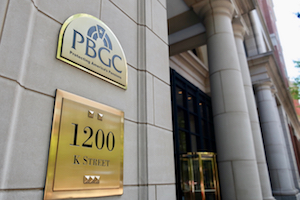 The Pension Benefit Guaranty Corporation (PBGC) reports that there is some good news for a change regarding its Multiemployer Program that provides financial assistance to multiemployer plans that become insolvent, to help them cover the cost of PBGC-guaranteed benefits to participants and the plan’s administrative expenses. But despite the good news, longer-term uncertainly remains concerning the program and its ability to assist plans that need it.
The Pension Benefit Guaranty Corporation (PBGC) reports that there is some good news for a change regarding its Multiemployer Program that provides financial assistance to multiemployer plans that become insolvent, to help them cover the cost of PBGC-guaranteed benefits to participants and the plan’s administrative expenses. But despite the good news, longer-term uncertainly remains concerning the program and its ability to assist plans that need it.
In its latest 5-year report about the program, the PBGC notes that while most multiemployer pension plans are not in danger of becoming insolvent, “almost all of them are underfunded.” Further, it says, some of the very large plans are severely underfunded and expect to need PBGC help. Consequently, says the PBGC in the report, it projected that the Multiemployer Program “would itself become insolvent by the end of FY 2026 and be unable to deliver the financial assistance needed by failed plans to pay benefits at the statutory guarantee level.”
The Multiemployer Program reported substantial contingent liabilities and increasing risk of insolvency, the PBGC says. As of Sept. 30, 2020 its had total assets amounted to $3.1 billion, overwhelmed by liabilities totaling $66.9 billion—more than 22 times as large as the assets.
But all that was before enactment of the American Rescue Plan (ARP) on March 11, 2021. Now, says the PBGC, the fortunes of the Multiemployer Program have turned around, at least in the shorter term. The PBGC says that its enactment “will significantly improve” the program’s finances. It explains that this is because plans facing financial challenges “will no longer be expected to require regular financial assistance, generally for at least the next 20 years and likely for longer.”
Due to the ARP, the PBGC now projects that current premiums will provide adequate resources to pay benefit guarantee levels to insolvent plans “until at least the mid-2030s and likely more than 30 years out.” In fact, says the report, the median year in which the Multiemployer Program is now projected to become insolvent has been extended from fiscal year (FY) 2026 to FY 2055.
But Some Clouds Persist
The good news is not unqualified, however. The report says that the actual solvency period will depend on what actually happens with those plans, including those that receive Special Financial Assistance (SFA) and other plans. “There is a high degree of uncertainty related to the solvency of financially troubled plans, which in turn creates a high degree of uncertainty on the solvency of PBGC’s Multiemployer Program,” says the report.
Further, says the report, with there being “significant uncertainty” regarding the impact of SFA on the projected solvency of plans, as well as the possibility that plans ineligible for SFA could become insolvent, it’s hard to determine what corresponding changes in the Multiemployer Program will be necessary to maintain its long-term solvency.
Premiums at a Premium
The report notes that the Multiemployer Program’s only sources of income (excluding appropriated funds used for SFA payments) are premium revenues and the investment income derived from them, which it describes as “modest.” Says the PBGC, “To maintain the solvency of the Multiemployer Program without additional taxpayer funding, premiums must be sufficient to cover current and future financial assistance payment obligations to insolvent plans.”
The report says that current projections suggest that current premium levels “will likely be insufficient to support the current level of the guarantee, leaving PBGC’s Multiemployer Program insolvent at some point in the future, most likely between the mid-2040s and the mid-2060s.”
And that insolvency portends a ripple effect for plans that depend on the program. “At the point of insolvency, PBGC would be unable to provide the regular financial assistance needed by insolvent plans to pay benefits at the statutory guarantee level, and its premium income at that point would be only a fraction of the amount needed to provide the guarantee,” says the PBGC.
Current premium levels—including the statutory increase in premiums under ARP beginning in 2031—would not support higher multiemployer benefit guarantee levels, the report warns.
But that danger may not be acute any time soon, the PBGC suggests. The report says that plans expected to receive SFA under ARP and other financially troubled plans that are narrowly excluded from SFA eligibility generally are projected to be solvent for approximately 30 years.
Employer Contributions
“A protracted decline in employer contributions for many plans” is another key factor underlying the challenges the multiemployer program faces, the report notes. This is less detrimental for plans with high funded ratios, the PBGC says; however, poorly funded plans, face greater challenges as a result. “Going forward, contribution experience will continue to be an important factor in the future solvency for many financially troubled plans, including SFA-eligible plans,” says the PBGC.
The report notes that plans that receive SFA must remain in critical status through plan year 2051, so they will be subject to a Rehabilitation Plan that may require them to increase their contributions. But this, too, is fraught with uncertainty: concerning how the Rehabilitation Plan requirements will affect plans that receive SFA and how the receipt of SFA may affect a plan’s ability to attract and retain active participants in order to increase Contribution Base Units and increase contribution income.
- Log in to post comments
